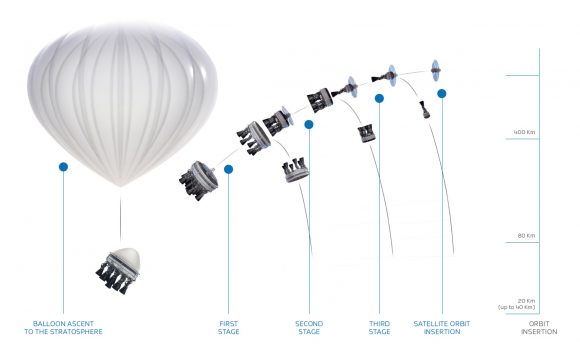Founded in 2009, the private aerospace company Zero2Infinity - which is headquartered in Barcelona, Spain - was created with the vision of delivering orbital payloads and providing space tourism on a budget. But unlike your conventional aerospace companies - i.e. SpaceX, Blue Origin, Orbital ATK, etc - their plan is to do it all using high-altitude stratospheric balloons.
On March 1st, the Zero2Infinity team passed a major milestone, deploying a prototype "rockoon" craft from the National Institute of Aerospace Technology's (INTA) facility in El Arenosillo, Spain. Known as Bloostar, this two-stage craft (which consists of a balloon and a rocket) is one of the latest technologies seeking to drastically reduce the costs of launching people and payloads into space.
As the name would suggest, the Bloostar craft consists of a first-stage balloon that carries a launch vehicle to altitudes of about 40 km (25 mi), where it is then engages its engine. By bringing a rocket to an attitude that is twice the cruising altitude of commercial aircraft, rockoons are capable of reducing the size of rockets and the amount of propellant needed to place payloads into orbit.
The launch vehicle itself is composed of a set of liquid fuel engines that are arranged in a concentric torus-configuration, which are then attached to the central payload. Each torus works as a stage during the rocket's ascent, once it has been ignited from around at deployment altitude. After all the rocket stages are are finished deploying the payload, they all return to Earth with the balloon where they are recovered.
In this respect, the Bloostar employs technology that is similar to what United Launch Alliance is exploring with the proposed mid-air recovery of their Vulcan rockets' engines. But the largest cost-cutting measure arises from the fact that the ignition phase does not start until the rocket is at an altitude that puts its beyond 95% of the mass of the Earth's atmosphere.
This also allows for additional flexibility with launches since it means getting above inclement weather, and also ensures that polluting emissions are not added to the lower atmosphere. The use of several torus-shaped stages reduces the chance of damage occurring to the launch vehicle on re-entry, since several small stages experience less in the way of air friction and heat than larger rocket states.
There is the added benefit of there being less chance of damage. Oftentimes, satellites have fold-out solar panels and science instruments that have to be tucked away to be able to fit inside the cargo hold of a launch vehicle. But with the Bloostar, they can be attached to the flat front end, and will experience less in the way of launch stress since they are floated into space instead of accelerated to escape velocity.

Diagram showing the various stages in the launch of he Bloostar. Credit: zero2infinity.space
For the sake of their test flight, the Bloostar's first-stage was elevated to an altitude of 25 km (15.5 mi) above sea level, a little over halfway towards their maximum deployment height. Once there, the launch vehicle conducted a successful ignition test. In addition to being a crucial milestone in the development of the prototype, the flight provided an opportunity to test several key subsystems and steps that will come into play.
These included the craft's telemetry systems, which needed to be tested in space. There was also the controlled ignition sequence and stabilization systems of the rocket, the launch sequence, the deployment of its parachute deployment, and finally, recovery of the engines at sea. And according to a news release issued by the company on Monday, March 13th, "All these goals were achieved in full."
This test was a first for the aerospace industry, as Zero2Infinity is currently the only company using stratospheric balloons as a first-stage vehicle. And already, the company states that it has garnered its fair share of interest from leading satellite developers, claiming that they have "gathered upwards of 250 million Euros in Letters of Intent for future launches."
In addition to Bloostar, the company also has a space tourism program in the works. Known as "Bloon", this service will offer clients the ability to travel to near-space aboard a stratospheric balloon for a chance to see Earth from suborbit. The purpose here is not just leisure, but to inspire people to appreciate the planet as a whole and help to protect it.
And then there's Elevate, which is the company's service for launching communications and weather-monitoring satellites, science experiments, stratospheric platforms, and other payloads to sub-orbital space. One of the more interesting packages they deployed in recent years was a Barbie doll in October of 2016, as part of Mattel's "Barbie to Space" PR campaign.
There is no doubt that the commercial aerospace sector (aka. NewSpace) plays an important role in the era of renewed space exploration. Whereas the Space Race was characterized by fierce competition between two rival superpowers and their respective federal space agencies, the new era is characterized by cooperation between multiple space agencies and (for he most part) healthy competition in the private sector.
With the development of reusable rockets, reusable launch components, and now reusable "rockoons", the costs of exploiting Low-Earth Orbit are dropping, and space itself is becoming far more accessible.
Further Reading: zero2infinity
No comments:
Post a Comment